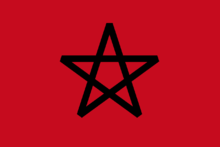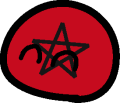Pagan Theocracy is a ![]() religious, culturally variable, civically variable, and economically variable and usually center ideology that wants paganism to be the ruling religion over the community. In state societies, this usually manifests itself in extreme
religious, culturally variable, civically variable, and economically variable and usually center ideology that wants paganism to be the ruling religion over the community. In state societies, this usually manifests itself in extreme ![]() authoritarianism and while may somewhat vary, often will execute those who have a different interpretation of pagan beliefs. However in tribal societies it often is extremely libertarian and varies greatly among practitioners of different areas and is generally much less statist and is usually more of a structure of social taboos to ensure the survival of the tribe and was "more or less" decided by the people of said tribe, whether it be through democratic vote and/or traditional societal roles such as elders or chiefs who often either were elected by the tribe and/or were given such power via tradition.
authoritarianism and while may somewhat vary, often will execute those who have a different interpretation of pagan beliefs. However in tribal societies it often is extremely libertarian and varies greatly among practitioners of different areas and is generally much less statist and is usually more of a structure of social taboos to ensure the survival of the tribe and was "more or less" decided by the people of said tribe, whether it be through democratic vote and/or traditional societal roles such as elders or chiefs who often either were elected by the tribe and/or were given such power via tradition.
History
(WIP) Pagan Theocracy has been almost as old as humanity itself. With traditions and superstitions often serving providing ways for humans to understand their place in life, eventually it has evolved all across the world to encompass various different non-monotheistic belief systems and pantheons. It could be argued that all major religions today started from Paganistic pantheons.
In Nations
The Roman Empire was this at certain times.
A good example of a hardcore pagan theocracy would be Mesoamerican empires such as the Aztec empire, which is known to be extremely extreme in their beliefs, and often being known to preform extreme rituals that often led to immense ammounts of sacrifice to the gods, examples being large-scale human sacrifice, child beatings and drowning, self-mutilation and constant warfare and razeing of enemy territories. But eventually due to outside disease and continued Colonialism from Western powers, as well as various native groups infighting with eachother, this way of life eventually collapsed and such traditions became a thing of the history books, although certain ![]() Indigenist political movements seek to revive aspects of Mesoamerican indiginous culture and beliefs such as
Indigenist political movements seek to revive aspects of Mesoamerican indiginous culture and beliefs such as ![]() Neozapatismo, albeit without such religious extremism or sacrificial rituals.
Neozapatismo, albeit without such religious extremism or sacrificial rituals.
Beliefs
Pagan Theocracy believes that a pagan religion should rule over the state. This was commonly done by either priests, druids, etc ruling or having power over the state in the name of the gods or by kings who called themselves a god. How they do it specifically depends on the pagan religion.
Variants
Ancient Near Eastern
Canaanite
WIP
 Egyptian
Egyptian
Ancient Egyptian Pagan belief centered on ![]() the Pharaohs, the rulers of Egypt, believed to possess divine powers by virtue of their positions. They acted as intermediaries between their people and the gods, and were obligated to sustain the gods through rituals and offerings so that they could maintain "Ma'at", the order of the cosmos, and repel "Isfet", which was chaos. The state dedicated enormous resources to religious rituals and to the construction of temples. While there is much debate to the extent the pharaoh was considered a god, it seems most likely that the Egyptians viewed royal authority itself as a divine force. Therefore, although the Egyptians recognized that the pharaoh was human and subject to human weakness, they simultaneously viewed him as a god, because the divine power of kingship was incarnated in him. He therefore acted as intermediary between Egypt's people and the gods.
the Pharaohs, the rulers of Egypt, believed to possess divine powers by virtue of their positions. They acted as intermediaries between their people and the gods, and were obligated to sustain the gods through rituals and offerings so that they could maintain "Ma'at", the order of the cosmos, and repel "Isfet", which was chaos. The state dedicated enormous resources to religious rituals and to the construction of temples. While there is much debate to the extent the pharaoh was considered a god, it seems most likely that the Egyptians viewed royal authority itself as a divine force. Therefore, although the Egyptians recognized that the pharaoh was human and subject to human weakness, they simultaneously viewed him as a god, because the divine power of kingship was incarnated in him. He therefore acted as intermediary between Egypt's people and the gods.
 Mesopotamian
Mesopotamian
WIP
 Tengrism
Tengrism
Tengrism (Turkish: Tengricilik In ancient Turkish:𐱅𐰀𐰭𐰼𐰃𐰲𐰠𐰃𐰚) is a pagan religion that ancient Turkish and Mongolian tribes believed in. The religion is both pantheistic and pagan and is currently only believed by some people in Turkey.
European
 Celtic
Celtic
WIP
 Druidist
Druidist
WIP
 Germanic
Germanic
WIP

 Hellenistic
Hellenistic 
Hellenistic Pagans, or Ancient Greek Pagans, worship a pantheon of many different gods and goddesses, most notably the Twelve Olympians. These gods were considered to be immortal, however they were not all-powerful, or even all-good. They were subordinate in power to the concept of fate, they behaved like humans and had human vices. They also could interact with humans and even have children with humans. Some gods were specifically associated with a certain city. Athena was associated with Athens, Apollo with Delphi and Delos, Zeus with Olympia and Aphrodite with Corinth. But other gods were also worshipped in these cities. Other deities were associated with nations outside of Greece; Poseidon was associated with Ethiopia and Troy, and Ares with Thrace.
 Norse
Norse
Ásatrú, also known as Norse Paganism, is one of the largest modern sects of paganism, and in Iceland, accounts for more than 1% of the entire population. Ásatrú hold the belief that there are multiple mortal Gods such as Odin, Thor and Freyja. Each God, or Áss, rules over a different part of the universe, for example thunder, war or the oceans. Æsir are not immortal, as shown by the story of the death of Baldr, nor are they omnibenevolent or omnipotent. The Æsir wage war with the Vanir, the secondary pantheon of Ásatrú. In terms of afterlife, Ásatrú believe that upon a death in combat, the soul is sent to Valhalla, hall of Odin, or Fólkvangr, hall of Freyja, where they will wait until the final battle with the Vanir at Ragnarök. Those who do not die in combat are believed to be reincarnated, with little interference from the Gods in the process.
Ásatrú is a highly liberal faith, as there is no strict dogma or holy book that teaches which exact beliefs to follow, so individuals are allowed to either devote themselves entirely to the pantheon, or simply be spiritual. Politically, Ásatrú value the preservation of the natural world, and are often environmentalists or primitivists, as well as a respect for traditional culture and faith. Ásatrú are divided over the importance of race and genetics in their religion, and subgroups espousing ![]() Odalism or
Odalism or ![]() Volkism have contributed to a far-right subsection of the faith. The far-right section of Ásatrú is more prevalent in America than Europe, and most European Ásatrú are liberal to left-wing, and Ásatrúarfélagið, the largest Ásatrú association in Iceland and Europe, has publically denounced these ideologies and supported the rights of Ethnic Minorities and the LGBT community. Ásatrú is a deeply divided faith with a bad reputation in America for its connections to the Far-Right, however elsewhere around the world, and for the vast majority of Ásatrú, the religion is one of peace and tolerance that encourages pacifism and ecologism over all.
Volkism have contributed to a far-right subsection of the faith. The far-right section of Ásatrú is more prevalent in America than Europe, and most European Ásatrú are liberal to left-wing, and Ásatrúarfélagið, the largest Ásatrú association in Iceland and Europe, has publically denounced these ideologies and supported the rights of Ethnic Minorities and the LGBT community. Ásatrú is a deeply divided faith with a bad reputation in America for its connections to the Far-Right, however elsewhere around the world, and for the vast majority of Ásatrú, the religion is one of peace and tolerance that encourages pacifism and ecologism over all.
 Roman
Roman
WIP
 Slavic
Slavic 
WIP
 East Slavic and
East Slavic and  South Slavic
South Slavic
WIP
 West Slavic
West Slavic
WIP
American Indigenous
 Aztec
Aztec
WIP
 Incan
Incan
Inca Theocracy is the rule under the religion of the Inca. The Inca people were polytheistic, but their most important god was Inti, the Sun god, whom the Inca believed the Inca Emperors to be the lineal descendants of. Ruling in the governmental system was done by the Sapa who ruled over an aristocracy made up of local elites directly recruited by the by the state to serve them.
The Inca economic system has been described as a primordial form of ![]() State Socialism, the economy was centrally planned, with redistribution of goods allocated based on which places needed them the most, this measure is said to have originated mainly as a way to prevent localized famines. There was no substantial internal market economy, bartering was limited to certain regions and no form of currency was in circulation in the general population, although axe-monies were employed by the mindaláe trading class to exchange goods with outsiders. Most common use goods were distributed by the ruling class in a direct exchange for labor and the economy rested on the material foundations of the traditional Andean Vertical archipelago model which complements the access to resources between different ecozones.
State Socialism, the economy was centrally planned, with redistribution of goods allocated based on which places needed them the most, this measure is said to have originated mainly as a way to prevent localized famines. There was no substantial internal market economy, bartering was limited to certain regions and no form of currency was in circulation in the general population, although axe-monies were employed by the mindaláe trading class to exchange goods with outsiders. Most common use goods were distributed by the ruling class in a direct exchange for labor and the economy rested on the material foundations of the traditional Andean Vertical archipelago model which complements the access to resources between different ecozones.
Due to the currencyless nature of the Inca empire taxation took the form of mit'a corvée labor, essentially a mandatory public service that extended from the similar village community service of mink'a that still remains in place in many Quechua communities to this day. Mit'a took the form of public jobs such as the construction of road infrastructure, agricultural terraces or fortifications. Besides the Mit'a there was also a form of compulsory military service.
In 1438, under the rule of Sapa Pachacuti Inca Yupanqui, the Kingdom of Cusco began a massive expansion campaign that lead the Incas to control the majority of the territory of modern day Peru. Due to the expansion a restructuration of power took place in which the Sapa was the head of the central government with 4 provincial governments controlled by strong leaders. As part of his expansionist policies the Sapa sent out spies to nearby regions he planned to expand to with messages to the leaders and presents that demonstrated the material benefits of joining the Inca empire, and would militarily conquer the ones who refused the offer.
Pachacuti's son, Túpac Inca Yupanqui, continued the expansionist policy of his father conquering most of modern day Colombia and Ecuador. Tupác's son Huayna Capac once more continued the expansionary policy of his grandpa conquering up to part of modern day Chile until the southern expansion stalled at the Battle of the Maule, turning to the west and expanding into parts of modern day Argentina and Colombia.
By 1529 the first Spanish conquistadors had reached the Inca empire, in 1532 a second wave had arrived with a charter allowing their conquest of Inca lands. During this time a civil war had broken out in the Inca Empire over which of Huyana's 2 sons, Huáscar and Atahualpa, would succeed him, with Atahualpa and his allies winning the war.
Between the diseases brought from Europe by the conquistadors, Atahualpa's capture and subsequent execution, the conquest of the Inca capital of Cusco (albeit it was reconquered briefly by the Incas) and the other military attacks the empire's strength was gradually weakened until it was fully conquered by the Spanish crown and the area was colonized.
 Mayan
Mayan
WIP
 Native American Spirituality/Creation Myths
Native American Spirituality/Creation Myths
 Haudenosaunee Confederacy
Haudenosaunee Confederacy
Has been argued to be a form of Proto-anarchism, influenced Karl Marx and his idea of "primitive communism" mythology, and structure a huge WIP.
 Inuit
Inuit
WIP
 Pacific Northwest Coast Tribes
Pacific Northwest Coast Tribes
WIP
Plains Tribes
WIP
Southwestern Tribes
WIP
Woodland Tribes
WIP
 Animist
Animist
WIP
 Solar
Solar 
WIP
 Neo-Pagan
Neo-Pagan
Wicca
WIP
New Age
WIP
Fictional
 Slavo-Aryan/Hyperborea
Slavo-Aryan/Hyperborea
Slavo-Aryanism is the ideology of a warlord state and formable nation called Hyperborea in the Hearts of Iron IV mod The New Order: Last Days of Europe. It is a Russian ultranationalist ideology which takes heavy influence from contemporary Hyperborean thought and ancient slavic aesthetics it believes that Slavs are the true Aryans.
They believe that prehistoric Europe was once dominated by an Aryan superculture who came from the levant that preserved their racial purity, built great works of art, and founded majestic cities. However, over time they were corrupted by deceitful Jewish interference, who manipulated them into intermarrying with lesser races and covered up their glorious heritage. Their descendants, who have fallen far but may regain their former glory, are now known as the "Slavic" people, To them, it is the Russians who are the heirs of the all-powerful Aryan race, and the Germans are actually inferior Asiatics who occupied Aryan lands at the behest of the jews so the people would achieve false racial consciousness, leading to a move away from Slavo-Aryanism.
Slavo-Aryanists believe in a syncretic mix of Slavic Paganism and other Indo-Aryan religions, who are also mixed with intense anti-semitism throughout its pratices and rituals, its mainly solidified under a belief in Perun, and also that the state should be theocratic with priests being the rulers and following the wills of the gods.
In terms of the state, Hyperborea is extremely totalitarian, with priest-kings supervising every minute detail to guarantee that all are behaving as proper aryans or proper slaves, with the High Priest being the highest position and having intense autocratic powers alongside being worshipped as a messenger of the gods, below him are the priest-kings who supervise the land, below them the priests and below them the average aryan citizens, below the aryans are all the peoples that they consider to be subhuman, who are treated as slaves, and below those are the jewish people who Slavo-Aryanists believe should be exterminated.
Slavo-Paganism rejects modern economics as either bolshevik weakness or jewish conspiracy, believing instead that the economy should be organized by priest-kings who give their orders on how the economy should be run based on the will of the gods, these Priest-Kings would also serve as supervisers and proselytizers in factories to guarantee that all are working in accordance to the ancient faith.
Personality and Behavior
Pagan Theocracy's personality depends on what pagan religion you're representing. Though there are some personality traits that are consistent. He has a very close relationship with nature. He also has a great respect for the gods.
How to Draw

- Draw a ball with a black outline
- Fill the ball with Red
- Draw the symbol of the pagan religion you're trying to represent. The default symbol is a black pentagram
- (Optional) Draw a hat that represents the pagan religion you're trying to represent
- Draw eyes
You are done!
| Color Name | HEX | RGB | |
|---|---|---|---|
| Red | #C60B1E | 198, 11, 30 | |
| Black | #141414 | 20, 20, 20 | |
Relationships
Friends
 Environmentalism - Shares my views on nature.
Environmentalism - Shares my views on nature. Deep Ecology - Really shares my views on nature.
Deep Ecology - Really shares my views on nature. Odalism - Really Really shares my views on nature.
Odalism - Really Really shares my views on nature. National Anarchism - Ah yes, the traditional way of life.
National Anarchism - Ah yes, the traditional way of life. Hindu Theocracy - Polytheism gang.
Hindu Theocracy - Polytheism gang. Tribalism - You are some of the chosen few who still follow the noble path of the gods.
Tribalism - You are some of the chosen few who still follow the noble path of the gods. Indigenism - We must follow the way of our ancestors spirits and seek justice for what had been done by Christian invaders.
Indigenism - We must follow the way of our ancestors spirits and seek justice for what had been done by Christian invaders. Anarkata - The White devil shall be driven back! And our way of life shall thrive once more!
Anarkata - The White devil shall be driven back! And our way of life shall thrive once more! Anti-Japaneseism - Glad to see you seek justice for what the Shintoists did to the indigenous pagans. But I still think you go too far sometimes...
Anti-Japaneseism - Glad to see you seek justice for what the Shintoists did to the indigenous pagans. But I still think you go too far sometimes... Anarcho-Primitivism - We must go follow our traditional way of life.
Anarcho-Primitivism - We must go follow our traditional way of life. Post-Colonial Anarchism - Not sure about this "Anarchism" but hey, seeking justice for indigenous peoples and wanting to revive their traditions and way of life seems based enough.
Post-Colonial Anarchism - Not sure about this "Anarchism" but hey, seeking justice for indigenous peoples and wanting to revive their traditions and way of life seems based enough. Primalism - A gift from the gods, who we live in harmony with, it shall willingly sacrifice itself in our ritual blood sacrifice!
Primalism - A gift from the gods, who we live in harmony with, it shall willingly sacrifice itself in our ritual blood sacrifice! Soulism - He too knows the wonders of Traditional Psychedelics and can truly see into the spirit realm.
Soulism - He too knows the wonders of Traditional Psychedelics and can truly see into the spirit realm.
Frenemies
 Satanic Theocracy - Going against the monotheists is based but you're very evil.
Satanic Theocracy - Going against the monotheists is based but you're very evil. Cultism - You seem to like me and all, but you don't actually seem to worship the spirits. (At least you took inspiration from the Aztecs for your mass human sacrifices though.)
Cultism - You seem to like me and all, but you don't actually seem to worship the spirits. (At least you took inspiration from the Aztecs for your mass human sacrifices though.) Neozapatismo - The Mesoamericans were based, But why don't you want to bring back human sacrifice? It was the best part!
Neozapatismo - The Mesoamericans were based, But why don't you want to bring back human sacrifice? It was the best part! Buddhist Theocracy - No gods? Kinda cringe but at least one of your sects believes in gods.
Buddhist Theocracy - No gods? Kinda cringe but at least one of your sects believes in gods. State Shinto - YOU TRAITOR! WHY DID YOU KILL OFF THE BASED JOMON, EMISHI, RYUKYU, AND AINU PAGANS? But your religion is cool, though.
State Shinto - YOU TRAITOR! WHY DID YOU KILL OFF THE BASED JOMON, EMISHI, RYUKYU, AND AINU PAGANS? But your religion is cool, though. Esoteric Fascism - I love the Gods too but I think you need to see a doctor because you keep spouting out crazy nonsense. Seriously, HOW the fuck are the Gods actually some ancient race of astronaut aliens?! Where are their spaceship remnants then?
Esoteric Fascism - I love the Gods too but I think you need to see a doctor because you keep spouting out crazy nonsense. Seriously, HOW the fuck are the Gods actually some ancient race of astronaut aliens?! Where are their spaceship remnants then? Tengrism - I mean Tengri is pretty cool but it is sad many of your followers abandoned your traditional roots to syncretism to monotheistics. Black Shamanism was far more based.
Tengrism - I mean Tengri is pretty cool but it is sad many of your followers abandoned your traditional roots to syncretism to monotheistics. Black Shamanism was far more based. Zoroastrian Theocracy - While monotheistic, at least you let us practice our religion in peace.
Zoroastrian Theocracy - While monotheistic, at least you let us practice our religion in peace. Post-Humanism - On one hand you completely destroy nature, on the other you're basically a god.
Post-Humanism - On one hand you completely destroy nature, on the other you're basically a god. State Atheism - You hate the Abrahamic religions? Based, but why do you hate me so much?
State Atheism - You hate the Abrahamic religions? Based, but why do you hate me so much? Pacifist Feminism - You take inspiration from me, but seeing how many of you are just a bunch of privileged internet-obsessed teenagers using my imagery for 'quirky' TikToks just feels so ignorant LARPer. How about actually following the path of the gods for once instead of following the path of social media?
Pacifist Feminism - You take inspiration from me, but seeing how many of you are just a bunch of privileged internet-obsessed teenagers using my imagery for 'quirky' TikToks just feels so ignorant LARPer. How about actually following the path of the gods for once instead of following the path of social media? Imperialism - You force your religion onto our people. But when pagans did it against monotheistics, it was based.
Imperialism - You force your religion onto our people. But when pagans did it against monotheistics, it was based.
Enemies
 Chinese Theocracy - THE YELLOW TURBAN REBELLION WAS BASED WHY DID YOU PURGE ME REEEEEEEEEEEEEEE!!! I AM GLAD THOSE TENGRI NOMADS KICKED YOUR ASS!
Chinese Theocracy - THE YELLOW TURBAN REBELLION WAS BASED WHY DID YOU PURGE ME REEEEEEEEEEEEEEE!!! I AM GLAD THOSE TENGRI NOMADS KICKED YOUR ASS! Christian Theocracy - YOU GOT RID OF MY INFLUENCE OVER THE ROMAN EMPIRE! DAMN YOU THEODOSIUS!!!
Christian Theocracy - YOU GOT RID OF MY INFLUENCE OVER THE ROMAN EMPIRE! DAMN YOU THEODOSIUS!!! Industrialism - You ruin nature!
Industrialism - You ruin nature! Islamic Theocracy - "Abu Talib, your nephew has reviled our gods, denounced our religion, derided our traditional values and told us that our forefathers were misguided."
Islamic Theocracy - "Abu Talib, your nephew has reviled our gods, denounced our religion, derided our traditional values and told us that our forefathers were misguided." Jewish Theocracy - Haha yeah keep seething about Hadrian! (I really don't hate Jews though, so please stop calling me an antisemite)
Jewish Theocracy - Haha yeah keep seething about Hadrian! (I really don't hate Jews though, so please stop calling me an antisemite) Reactionary Socialism - Evil commie who wants to burn me at the stake.
Reactionary Socialism - Evil commie who wants to burn me at the stake. Liberation Theology - Lol, you are just butthurt that
Liberation Theology - Lol, you are just butthurt that  he likes me more than you... Stop cucking out to worshiping a Jew on a stick and betraying your ancestor's true beliefs.
he likes me more than you... Stop cucking out to worshiping a Jew on a stick and betraying your ancestor's true beliefs. Kratos - STOP KILLING MY GODS YOU MONSTER!!
Kratos - STOP KILLING MY GODS YOU MONSTER!!
Further Information
Wikipedia
- Imperial cult
- Pharaoh
- Roman emperor
- Imperial cult of ancient Rome
- Paganism
- Religion in the Inca Empire
- Inca Mythology
- Inti (Inca Sun God)
Literature
- The Iliad-Homer

- Beowulf-Unknown

- The Golden Bough-Sir James George Frazer
- The Poetic Edda-Unknown

- The Prose Edda-Snorri Sturluson

- The Mabinogion-Unknown(translated by Lady Charlotte Guest)

- The Odyssey-Homer

References
Gallery
Portraits
-
Old portrait
Alternative designs
-
Annunakism
-
Norse Theocracy
-
Totemism
Comics and Artwork
| | |






